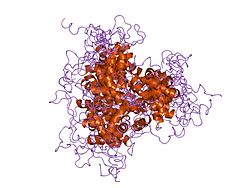FOXD3
Appearance
Ensembl | |||||||||
|---|---|---|---|---|---|---|---|---|---|
| UniProt | |||||||||
| RefSeq (mRNA) | |||||||||
| RefSeq (protein) | |||||||||
| Location (UCSC) | Chr 1: 63.32 – 63.33 Mb | Chr 4: 99.54 – 99.55 Mb | |||||||
| PubMed search | [3] | [4] | |||||||
| View/Edit Human | View/Edit Mouse |
Forkhead box D3 also known as FOXD3 is a forkhead protein that in humans is encoded by the FOXD3 gene.[5]
Function
This gene belongs to the forkhead protein family of
transcription factors which is characterized by a DNA-binding forkhead domain. FoxD3 functions as a transcriptional repressor and contains the C-terminal engrailed homology-1 motif (eh1), which provides an interactive surface with a transcriptional co-repressor Grg4 (Groucho-related gene-4).[6]
Stem Cells
Multiple studies have suggested Foxd3 involvement in the transition from naive to primed pluripotent stem cells in embryo development. Previously, Foxd3 was demonstrated to be required in maintaining pluripotency in mouse
Brg1, a nucleosome remodeler, and then acts as a repressor of maximal activation of those enhancers by recruiting histone deacetylases, suggesting a complex mediating function in which enhancers are primed for some future controlled time-point rather than immediate expression.[9] While there is no ambiguity that Foxd3 plays an important role regulating the transition from naive to primed pluripotency state, the two models show a different process. Attempts to reconcile the conclusions of the two studies have further suggested that Foxd3 functions as all of the above.[10]
Neural Crest Cells
FOXD3 plays an important role in the development and differentiation of neural crest cells.[11] Specifically, it is thought that FOXD3 plays an important role in controlling the developmental switch between Schwann Cell Progenitors and Melanocytes.[11]
Clinical significance
Mutations in this gene cause vitiligo.[12]
References
- ^ a b c GRCh38: Ensembl release 89: ENSG00000187140 – Ensembl, May 2017
- ^ a b c GRCm38: Ensembl release 89: ENSMUSG00000067261 – Ensembl, May 2017
- ^ "Human PubMed Reference:". National Center for Biotechnology Information, U.S. National Library of Medicine.
- ^ "Mouse PubMed Reference:". National Center for Biotechnology Information, U.S. National Library of Medicine.
- PMID 8499623.
- PMID 17138566.
- PMID 12381664.
- PMID 26748758.
- PMID 26748757.
- PMID 27868055.
- ^ PMID 23858437.
- PMID 16098053.
Further reading
- Guo Y, Costa R, Ramsey H, Starnes T, Vance G, Robertson K, et al. (March 2002). "The embryonic stem cell transcription factors Oct-4 and FoxD3 interact to regulate endodermal-specific promoter expression". Proceedings of the National Academy of Sciences of the United States of America. 99 (6): 3663–3667. PMID 11891324.
- Levy D, Larson MG, Benjamin EJ, Newton-Cheh C, Wang TJ, Hwang SJ, et al. (September 2007). "Framingham Heart Study 100K Project: genome-wide associations for blood pressure and arterial stiffness". BMC Medical Genetics. 8 (Suppl 1): S3. PMID 17903302.
- Saleem RA, Banerjee-Basu S, Berry FB, Baxevanis AD, Walter MA (March 2001). "Analyses of the effects that disease-causing missense mutations have on the structure and function of the winged-helix protein FOXC1". American Journal of Human Genetics. 68 (3): 627–641. PMID 11179011.
- Buescher JL, Martinez LB, Sato S, Okuyama S, Ikezu T (March 2009). "YY1 and FoxD3 regulate antiretroviral zinc finger protein OTK18 promoter activation induced by HIV-1 infection". Journal of Neuroimmune Pharmacology. 4 (1): 103–115. PMID 19034670.


